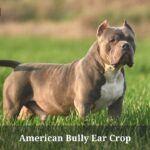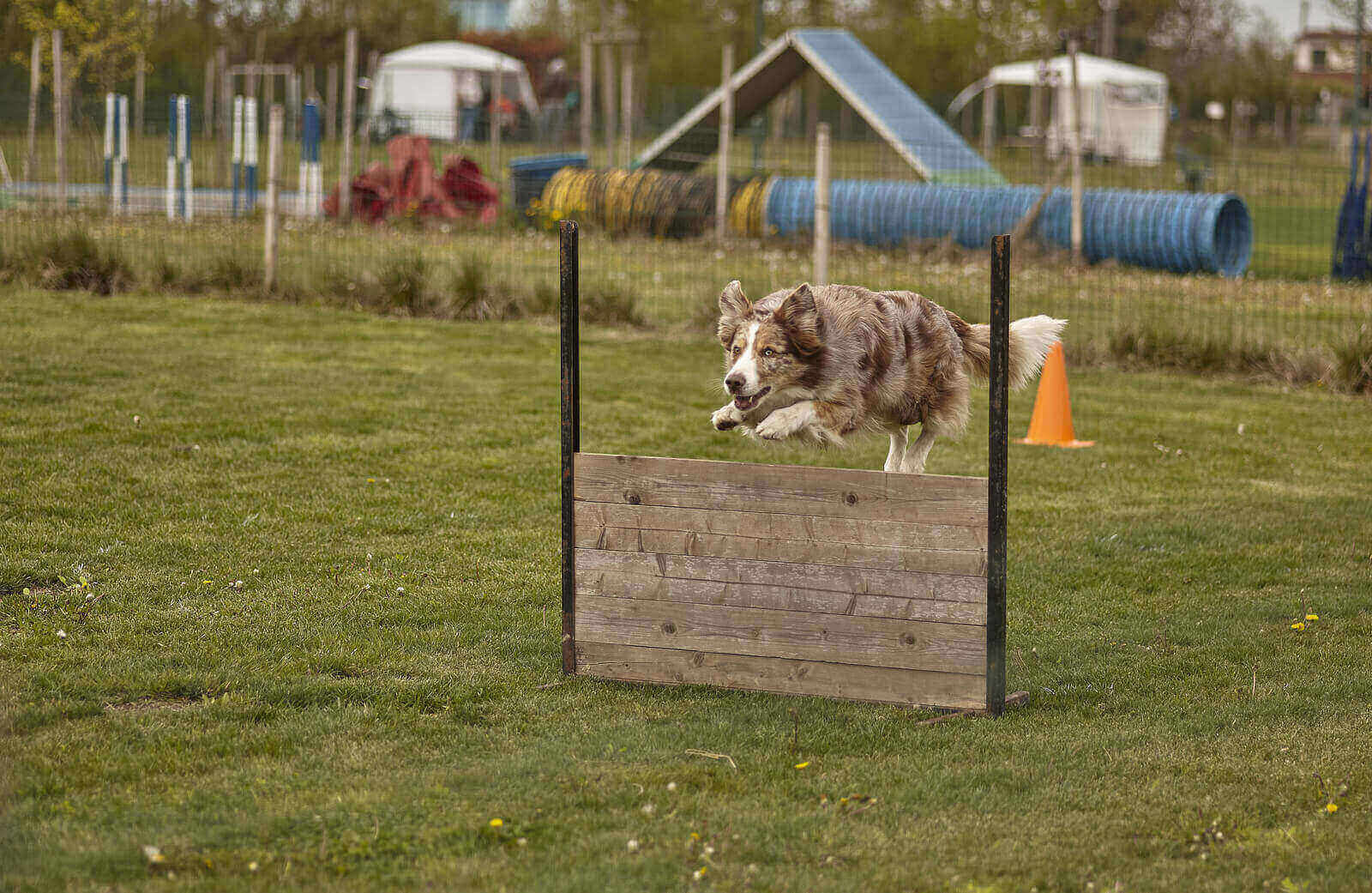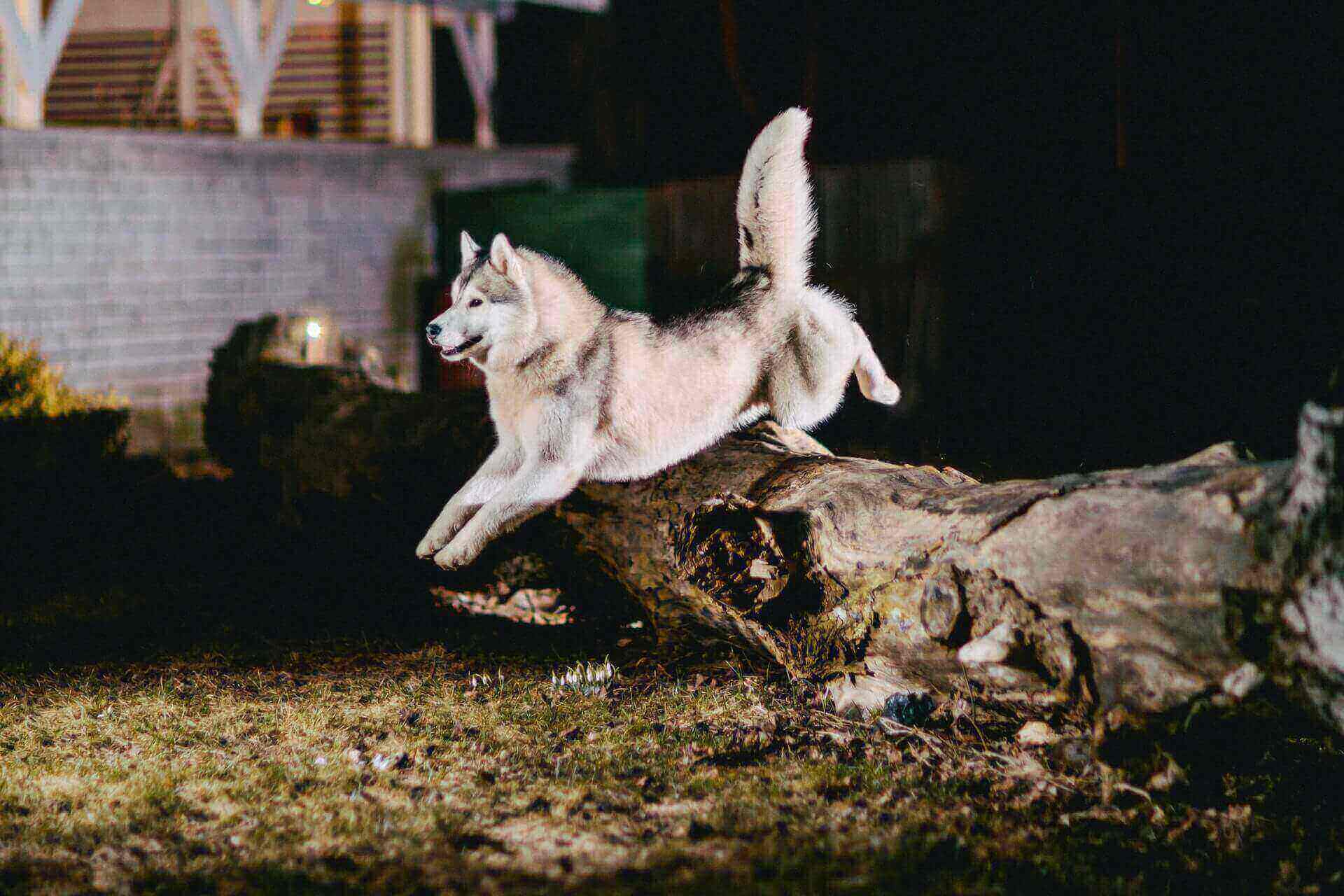Are you considering acquiring a Doberman dog? Or have you recently acquired a Doberman? In either case, one of the decisions you may have to make soon or later is on whether to have the dog’s ears cropped.
In this article, you will find information on the possibility of leaving the Dobermans’ ears uncropped.
Leaving the Doberman ears uncropped means that they will remain with a droopy (or flopped) appearance and posture. Such ears may be slightly more prone to infections, and have somewhat lower ability to localize sound.
But opting for uncropped Doberman ears also saves the dog from a painful, risky and often unnecessary procedure.
The practice of cropping Doberman ears is so widespread in some places that people have no idea what Doberman natural ears look like.
In such places, finding a Doberman with natural ears is unlikely. Actually, people may have come to believe that cropping Dobermann ears is mandatory. Yet nothing could be further from the truth.
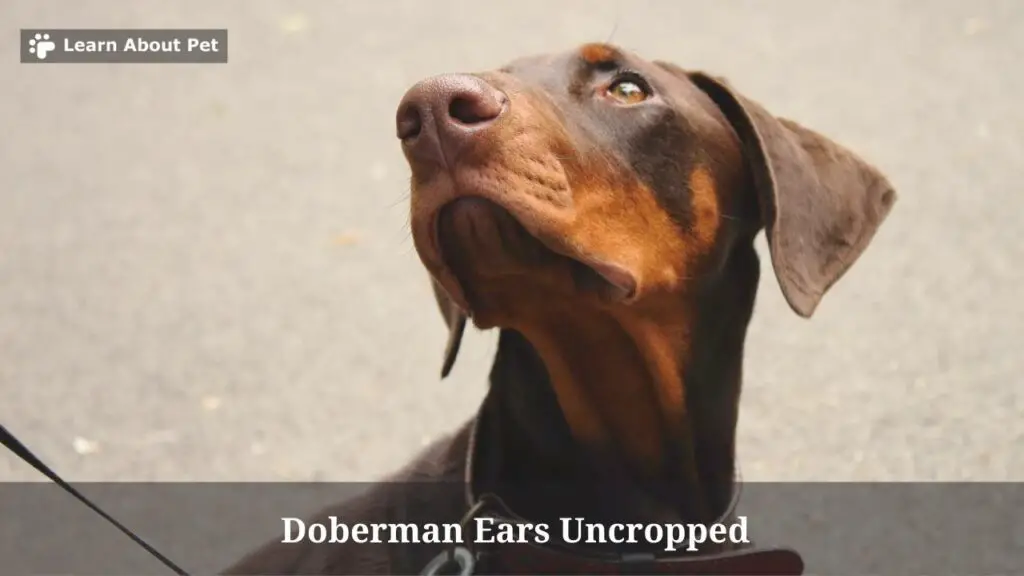
In fact, a Doberman with ears that are uncropped looks almost as good as a Doberman with clipped ears. Having the Doberman ears clipped confers very little, if anything, in terms of tangible benefits.
That is why some people are opting to take the Doberman no crop route: by leaving the Doberman ears natural (uncropped).
To make sense of the whole thing though, we first need to understand the cropping in question and why it is done. So we need to start by asking ourselves, why do Dobermans get their ears cropped?
Why Are Doberman Ears Cropped?
Dobermans are among the breeds of dogs that often have their ears cropped. It is a very widespread practice, especially in places where it is still legal.
But why are the Doberman ears cropped?
To answer this question, we have to start with the broader one on why do people crop dogs’ ears?
The answer is that people crop their dogs’ ears for cosmetic, as well as presumed practical and medical reasons.
With regard to the cosmetic factor, there are those who believe that dogs with cropped ears look better.
Turning to the practical aspect, we have those who believe that dogs with cropped ears are better at localizing sound.
And turning to the medical factor, we have folks believing that cropping dogs’ ears make them less prone to infections.
These are also the factors that push people into cropping their Dobermans ears.
The cosmetic factor is particularly strong here. There are people who believe that uncropped Doberman ears don’t look good.
To prove their point, they usually lay pictures of Dobermans with uncropped ears side by side with those of cropped Doberman dogs. Or they may use the pictures of one Doberman dog – before and after cropping.
So you find Doberman ear cropping before and after pictures.
They then use the said Doberman before and after ear cropping pictures as justification for the cropping practice…
Their basic claim is that having a Doberman cropped enhances its appearance. They go to great lengths, in undertaking Doberman cropped ears vs uncropped comparisons, to prove their point.
Inevitably, they skew their Doberman ears cropped vs uncropped comparisons, to show that the cropped Dobermans look better.
And that then becomes the key justification for the Doberman ear posting (or cropping) practices.
The Practical And Medical Reasons For Cropping Doberman Ears
Beyond the cosmetic reasons for cropping Doberman ears, proponents of Doberman ear cropping also advance practical and medical ‘reasons’ for the practice.
On the practical side of things, the key argument is that a Doberman dog with uncropped ears is less able to localize sound.
And on the medical side of things, the core argument is that leaving the Doberman ears uncropped would make it more prone to ear infections.
There are people who have undertaken uncropped Doberman cropped ears comparisons with regard to these things.
Leaving the Doberman uncropped doesn’t seem to affect its ability to localize sound greatly. The difference between a Doberman with uncropped ears and one with cropped ears, when it comes to localizing sound, is very little.
In fact, with regard to hearing ability, the uncut Doberman ears may also confer certain advantages.
As to whether the Doberman uncropped ears are more prone to infections, there is little evidence. It is true that the Doberman undocked ears may accumulate moisture and heat more.
That accumulation of moisture and heat in the natural ears Doberman dogs come with may make them slightly more prone to infections.
But if proper hygiene practices are adhered to, a Doberman with unclipped ears should just be alright.
All that a Doberman with uncropped ears may require is frequent wiping of the ears’ interiors.
Ultimately, if having a Doberman not cropped has an impact on infection vulnerability, that effect is modest.
In the dog fighting era though, the cropping did confer real benefits. An uncut Doberman would be at a disadvantage, when fighting. Thus in a Doberman non cropped ears would be a liability.
This is because a Doberman with uncropped ears and tail would be more easily latched upon by opponents.
What Does Doberman Ear Cropping Entail?
In this sort of discussion about cropped and uncropped Doberman ears, one question is bound to come up. That is on what do they do to Dobermans ears while cropping them?
The truth of the matter is that cropping Doberman ears is a three step process.
In the first step, the dog is put under anesthesia. So we are dealing with an actual surgical operation here.
In the second step, the dog’s ear’s pinna is cut.
And in the third step, the dogs’ ears are tapped, to get them to start being upright. The solid thing that is taped onto the ears remains there, until such a time that the ears are able to remain upright without it.
Here, one may ask, does cropping Dobermans ears hurt them? And the answer is ‘yes’. It does. That is why it has to be done under anesthesia. And that is why the dogs may require pain relief medications thereafter.
In fact, it is precisely due to the pain factor that some people opt to have Doberman not cropped ears.
Opting to leave a Doberman with uncut ears means that it doesn’t have to endure this sort of pain.
What Does A Doberman With Uncropped Ears Look Like?
The natural ear Doberman dogs are born with is usually broad and floppy.
Thus if you opt to leave Doberman ears not cropped, they will remain broad and flappy.
The point of having cropped ears on Dobermans is to make them upright. That is the whole idea behind the Dobermann clipped ears (in which the clipping is followed by taping, to make the ears upright).
Consequently, an uncropped Doberman is a floppy ear Doberman. Its ears are broad, and they lie on its head: they are floppy ears.
The Doberman uncut ears don’t affect its overall appearance in any other way though. There are those who advance an argument that the uncropped ears make the dog look less fierce…
For perspective’s sake, you can undertake a Great Dane cropped vs uncropped ears comparison, with regard to appearance. Does the Great Dane with uncropped ears look substantially different from one with cropped ears?
If not, why then would one expect Doberman clipped ears (or cropped ears) to make that much of a difference?
Ultimately, uncropped Doberman puppies look like all other Doberman puppies: only that their ears are flappy. Just place Doberman puppies with uncropped ears side by side with those with cropped ears.
That is the only difference you will notice.
Similarly, a full grown Doberman with uncropped ears looks like any other full grown Doberman: only that its ears are flappy.
This is also what a Doberman Pinscher uncropped ears vs cropped ears objective comparison would reveal.
In fact, when doing that sort of a Doberman Pinscher cropped ears vs uncropped ears comparison, you may at first notice no difference. Thus if cropping affects appearance, it is only marginally.
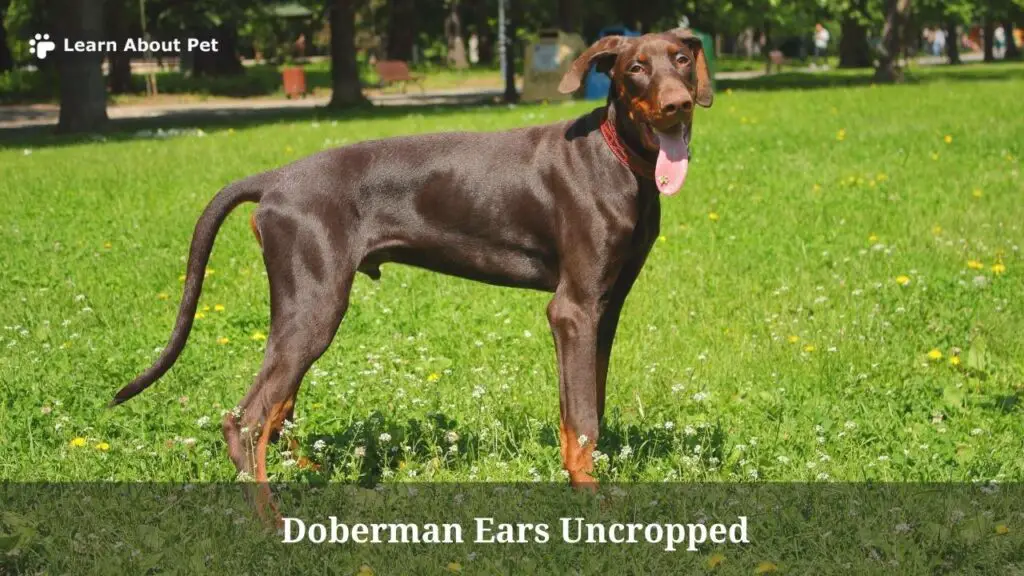
What Are The Benefits Of Cropping Dobermans Ears?
Proponents of Doberman ear cropping say that it makes the dogs look more aesthetically appealing.
Some have actually gone to great lengths, to come up with intricate Doberman ear cropping styles (as well as Doberman tail docking styles), all for cosmetic purposes.
So they tell you that if you have not cropped Doberman ears, the dog doesn’t look good enough.
So there is this purported cosmetic benefit.
Proponents of Doberman ear cropping also say that it improves the dogs’ ability to localize sound.
Indeed, if you undertake a Doberman cropped vs not cropped ears comparison with regard to sound localization ability, you notice this sort of effect. But the benefit is very modest.
A further more objective Doberman cropped vs uncropped ears hearing ability comparison will reveal that leaving the ears in their natural state also confers some advantage.
At the very least, the inner parts of uncropped Doberman ears are less exposed to harm. That is thanks to the floppy nature of the ears.
Yet another purported benefit of Doberman ear cropping is with regard to infection vulnerability. So the argument is that the uncropped Doberman ears are more prone to infections than cropped ones.
Thus cropping the ears is said to make them less prone to infections.
What Are The Benefits Of Leaving Doberman Ears Uncropped?
One benefit of leaving Doberman ears uncropped is in the fact that you then get to save the dog from unnecessary pain.
As we saw earlier, cropping of a Doberman’s ears is a painful affair. If you opt to forego the operation, you save the dog from that pain.
Another benefit of not cropping a Dobermans ears is in the fact that doing so leaves the dog looking natural. So the dog’s look is unaltered, which is very critical.
For instance, you only need to compare a European Doberman with uncropped ears with an American Doberman with cropped ears. You will see that the one with uncropped ears looks more authentic.
Or you can pick any Doberman color: say red. Then compare a red Doberman with uncropped ears with one whose ears are cropped. You will see that the clipped Doberman ears actually make it lose quite a bit of its authenticity.
Thus leaving the Dobberman ears uncropped is important, if you want to maintain authenticity.
At yet another level, Doberman non clipped ears make it look less aggressive. For instance, in a male Doberman uncropped ears result in a less fierce-looking dog than cropped ones.
Generally, in a Doberman uncropped ears and tail make the dog look much less aggressive.
That is important if you want a pet Doberman that is not too scary.
Ear cropping can be a risky surgical operation. Opting not to crop your Doberman ears saves the dog from that operation. And this too is important when making the Doberman cropped ears or not cropped ears decision.
We could also say that opting not to crop your Doberman save you the money you’d otherwise have spent on the cropping operation.
Is It A Must To Crop Doberman Ears?
It is not mandatory to crop Doberman ears.
There are places where Doberman cropping is so widespread that people have to believe that it is mandatory. It isn’t. Many people usually only crop their Dobermans because they want them to look ‘conventional’.
So it is a peer pressure thing. But it is not mandatory.
Is It Necessary To Crop Doberman Ears?
We have looked at the purported ‘benefits’ of cropping versus those of leaving a Dobermans’ ears uncropped.
You just have to weigh the purported benefits against the risks. Just carry out a Doberman cropped ears vs not cropped ears objective comparison.
Then ask yourself whether the cropped ears Doberman dogs end up with after the procedure are worth the risk.
Many anti animal cruelty activists seem to be of the view that Doberman ear cropping is not really necessary. In fact, in some places, it has been made illegal.
Where Is Doberman Ear Cropping Done?
Doberman ear cropping is done in vet clinics.
It is quite an intricate surgical operation, which is best done at a vet’s clinic.
Some people may try to give tutorials on how to crop Doberman ears at home. But that would be very cruel (as it would mean no anesthesia) and also very risky.
Doberman ear cropping should be done at vet clinics –if it has to be done.
Should I Have My Dobermans Ears Cropped?
Ultimately, the decision on whether or not to have your Dobermans ears cropped is upon you.
We have seen that any benefits that a Doberman stands to get from ear cropping are marginal (at best). Yet the Doberman ear cropping risks are very real.
You then need to weigh the Doberman ear cropping pros against the cons, to arrive at a conclusion.
Final Verdict – Doberman Ears Uncropped
Doberman ear cropping entails cutting a portion of the pinna, then taping the ears to an upright object. This is done with the objective of getting the ears to be upright on their own.
Doberman ears are by default floppy. Cropping aims to make them upright.
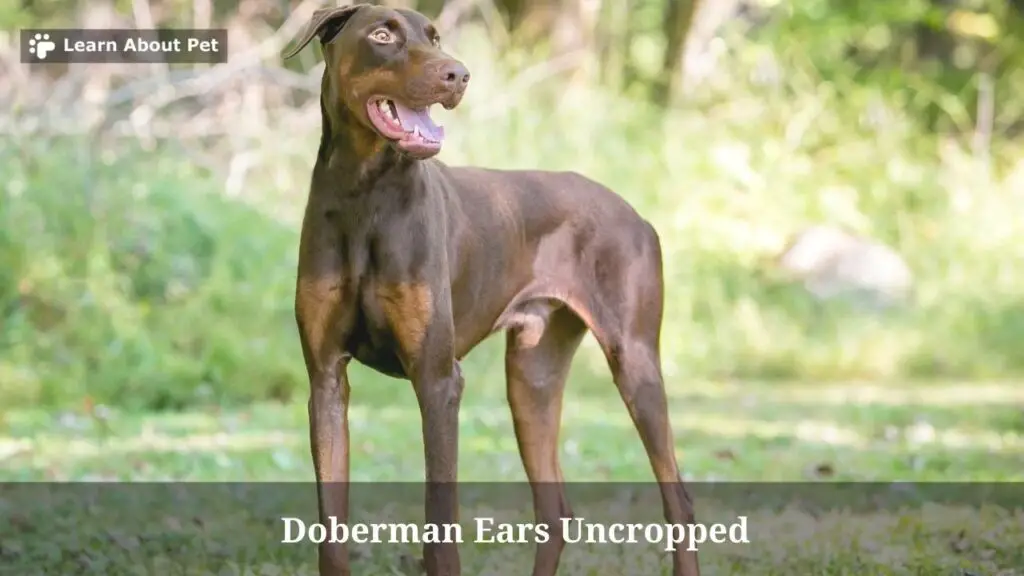
There is also the option of leaving the Dobermans’ ears uncropped. Ear cropping is a painful, risky and often expensive procedure. Opting to keep the Dobermans’ ears uncropped saves the dog from the risk and pain.
It also saves you from the expense.
If you opt to leave your Dobermans’ ears uncropped, all you need to do is ensure that you wipe them frequently. This should deal with the ‘proneness to infection’ that Doberman ear cropping is purported to minimize.
As a pet lover, make sure to learn about pet more and give your pet dog a good and comfortable life!

Welcome to Learn About Pet. My name is Rajkumar Ravichandran and I love all pets, travel, and amazing food. I write about my passion and personal experience caring for multiple pets in this blog! ❤️
Post Disclaimer
DISCLAIMER: THIS BLOG OR WEBSITE, "Learn About Pet", DOES NOT PROVIDE YOU WITH MEDICAL ADVICE AND IS NOT A SUBSTITUTE FOR MEDICAL ADVICE. ALWAYS GET IN TOUCH WITH YOUR PERSONAL VETERINARIAN AND USE INFORMATION HERE AS GENERAL ADVICE.
The information, including but not limited to, text, graphics, images and other material contained on this website are for informational purposes only. No material on this site is intended to be a substitute for professional veterinary advice, food recommendation, diagnosis, or treatment. Always seek the advice of your veterinarian or other qualified health care provider with any questions you may have regarding a medical condition or for pet food related questions.
